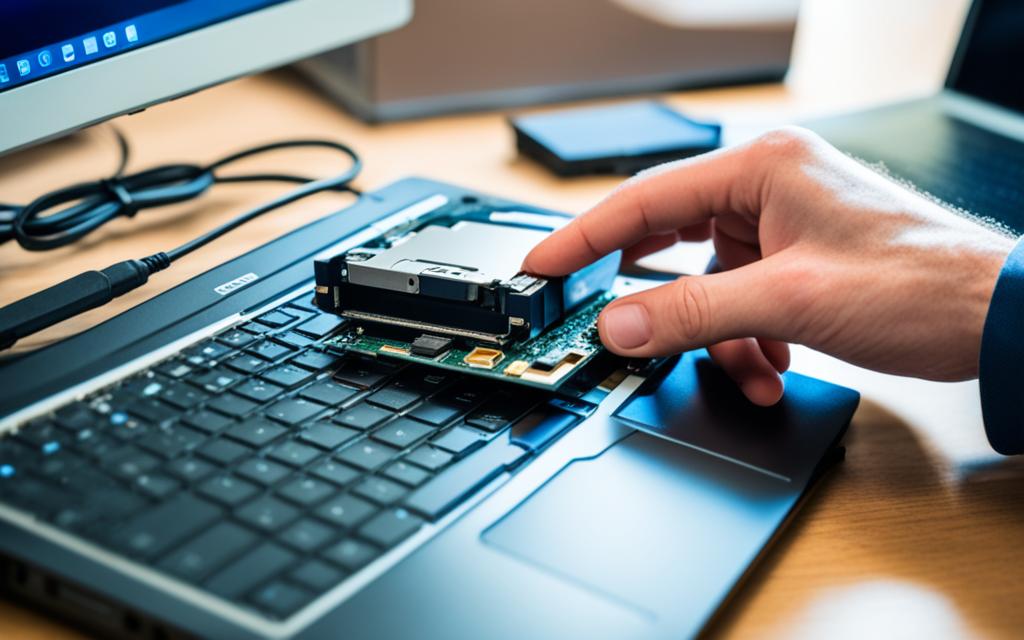Table of Contents
Connecting an internal HDD to your laptop goes beyond technical steps. It’s a chance to boost your device’s performance and storage. With more need for managing data, increasing your laptop’s storage makes accessing files smoother. We’ll guide you on how to connect an HDD to a laptop easily. You’ll learn about the tools needed and get step-by-step instructions. Our goal is to help you feel confident in upgrading your laptop storage. For methods on accessing data from old hard drives, see this in-depth guide to connecting hard drives.
Key Takeaways
- Understanding the importance of upgrading storage in a laptop.
- Exploring the types and compatibility of HDDs.
- Learning the essential preparations before connecting an HDD.
- Step-by-step methods to connect your HDD effectively.
- Gaining insight into ensuring your new hard gradually drive is correctly configured.
Understanding the Importance of Storage Expansion
In today’s world, we create more data than ever before. This shows how crucial storage expansion is. People fill up their devices with files, photos, and apps quickly. Upgrade laptop storage options are important for those running out of space. Modern storage solutions can boost your device’s performance and hold more data.
Why Upgrade Your Storage?
Adding more storage to your laptop means it can run more apps and run them faster. More storage makes everything smoother, cutting down on freezing and waiting. About half the people given external drives for online learning feel lost about how to use them1. This shows the need for help in managing storage efficiently.
Benefits of Using an HDD
HDDs are great for those looking for affordable storage options. They offer more space for big files like videos. HDDs often come with a 3-5 year warranty, but cheaper models may last less1. Many HDDs include SMART diagnostics. This helps spot problems before they happen1. Plus, plugging in an external HDD to a Windows system usually shows it within 30 seconds2, making it easy to integrate your data.
HDDs make managing your files easy. You can move files with simple copy-and-paste or drag-and-drop actions. With all these features, HDDs meet today’s rising digital storage needs well. They let users handle their data without worrying about running out of space.
| Feature | HDD | SSD |
|---|---|---|
| Cost per GB | Lower | Higher |
| Capacity | Up to 20TB | Up to 8TB |
| Lifespan | 3-5 years (budget drives may vary) | 5-10 years |
| Speed | Slower read/write speeds | Faster read/write speeds |
Looking at these aspects helps in deciding on storage options. This is vital if you’re thinking of upgrading to solve storage issues.
Choosing the Right Hard Disk Drive
When you’re picking a hard disk drive (HDD) for your laptop, it’s crucial to know the different kinds available. You’ll mainly come across SATA and IDE interfaces. Each has unique benefits that affect how well they work and fit with your system.
Types of HDDs: SATA vs IDE
SATA drives are known for faster data speeds, reaching up to 600 MB/s, unlike IDE drives which max out at 133 MB/s. This makes SATA the go-to for high-speed needs like gaming or graphic design3. HDDs operate at speeds from 5,400 to 7,200 RPM. This range allows you to choose based on how quickly you need to access your data4.
Determining Compatibility with Your Laptop
It’s vital to make sure the HDD fits your laptop’s specs. Most laptops work with 2.5-inch drives. Desktops, on the other hand, typically use 3.5-inch ones4. You should check your laptop’s guide or the manufacturer’s site for HDD compatibility. This ensures the drive not only fits but also works well with your device3.
Preparing Your Laptop for HDD Connection
Before you start connecting a new HDD to your laptop, make sure your data is safe. This step is crucial to avoid losing any information during installation. You can back up your files using external drives, cloud services, or dedicated backup software. It’s important to feel confident that your backups are secure.
Backing Up Your Data
The very first move is to backup your files when adding a new hard drive. Whether it’s through an external drive, the cloud, or backup software, picking the best option is key. Regular backups protect you from hardware crashes, mistakes, and corrupted data.
There are lots of tools and resources that make backing up easier. Using backup software can help manage your data easily. This way, if something goes wrong during setup, you can quickly go back to a safer point.
Safety Precautions Before Handling Hardware
It’s important to take safety measures before you start the HDD installation in your laptop. Make sure the laptop is off and not plugged in to avoid electronic shocks or damage. A space free from static is vital because static can harm the internals of the laptop.
Before you touch any parts, grounding yourself is necessary to protect the electronics. Put the HDD on a steady surface with good air flow. Keep your hands off the connectors.
Sticking to these backup and safety tips helps ensure a smooth HDD upgrade for your laptop. These precautions set you up for a trouble-free improvement. They merge safety with know-how56.
How to Connect HDD to Laptop
Want to add more storage to your laptop? Knowing how to connect an HDD is key. You’ll need some tools to get it done right. Follow this guide for a smooth HDD installation.
Required Tools and Materials
You’ll need a few things before you start:
- Screwdriver (usually Philips head)
- SATA-to-USB adapter, ideal for connecting the HDD externally
- External hard disk enclosure, if necessary for a portable connection
- Static wrist strap to prevent electrostatic discharge
- Backup storage device for safeguarding your data
Step-by-Step Instructions
Here’s how to connect your HDD:
- Backup Your Data: Always back up important information first.
- Turn Off the Laptop: Make sure your laptop is off and unplugged.
- Ground Yourself: Touch a metal surface to prevent damage from static.
- Open the Laptop: Carefully open the back with a screwdriver.
- Remove Existing Drive: Take out the old HDD if there’s one.
- Insert New HDD: Put in the new 1 TB HDD, making sure it’s properly fitted. Most laptops need a 2.5-inch SATA drive78.
- Connect External Drives: For external HDDs, use the SATA-to-USB adapter or external enclosure.
- Replace the Back Panel: Put the back panel on and screw it tight.
- Power On the Laptop: Turn on the laptop and check the BIOS for the new drive.
- Format and Partition: Use Windows 10 Disk Management to set up the new drive.
By following these steps, you should have no trouble adding an HDD to your laptop78.
Configuring the New Hard Drive
After connecting the new hard drive, you need to configure it. This makes it work better. You have to format and partition the HDD. Also, make sure it shows up in the BIOS setup.
Formatting and Partitioning Your HDD
To use the hard drive, you must format it first. Make sure you choose NTFS for Windows to get the best performance. Next, dividing the HDD into smaller parts is a good step. It helps in organising your files better.
You can set the size of these parts during setup. This makes storing and accessing files more efficient. It’s also great for backing up data or using different operating systems on the same drive910. Once you’ve done this, each section will show as a separate drive in File Explorer. They’ll have their own drive letter and label5.
Ensuring BIOS Detection
Getting into the BIOS setup is key. You need to check if the system detects the new hard drive. Normally, you can enter the BIOS by hitting DEL or F2 when the computer starts5.
Look for the storage settings in the BIOS. Make sure your new drive is on the list. This step is crucial to make sure the drive works well with your system9. Once you see the drive is detected, save your changes and exit. This ensures your system will run smoothly.
Conclusion
Connecting an HDD to your laptop boosts your storage space. This is key for both your personal and work tasks. Following the right steps ensures a high chance of success. This means more efficient data storage and management11. With the HDD set up correctly, your computer will start up faster and work smoother12.
Choosing an HDD brings many benefits. It lets you save important files safely, reducing the chance of losing them13. Upgrading your laptop this way improves your work. It also helps you manage your files better.
Internal drives now are both affordable and faster. Knowing this makes the decision to upgrade easy11. Learn what you need to do. This way, you’ll boost your laptop’s storage and its overall performance.
FAQ
What are the benefits of upgrading my laptop’s storage?
Boosting your laptop’s storage improves performance. It lets you keep more apps, files, and videos. This makes it easier to organise your data and access important files quickly, enhancing your computing experience.
How do I know which type of HDD is compatible with my laptop?
Finding the right HDD for your laptop requires checking its manual or the manufacturer’s website. Look for the interface type (SATA or IDE) and the maximum storage capacity. This ensures the new drive will fit and work well.
What precautions should I take before installing an HDD?
Always back up your data to avoid loss. Before starting, turn off and unplug your laptop. Work in a place without static and ground yourself to prevent damaging your laptop with static electricity.
What tools will I need to connect an external HDD to my laptop?
You will need a screwdriver, a SATA-to-USB adapter, and maybe an external enclosure to connect an external HDD. Having these tools makes the setup quick and easy.
How can I format and partition my new HDD?
Once your new HDD is connected, format and partition it using your laptop’s OS. Go to the disk management tool, choose the new drive, and follow the steps. This will get it ready for storing and accessing your data.
What should I do if my laptop does not recognise the new HDD?
If the new HDD isn’t showing up, double-check its connection. Then, look in the BIOS setup at startup to make sure the laptop sees the drive. You might need to adjust the settings for it to work right.
Source Links
- https://www.backblaze.com/blog/a-beginners-guide-to-external-hard-drives/ – How to Set Up and Use an External Hard Drive
- https://www.seagate.com/support/kb/what-happens-when-i-connect-my-external-drive-for-the-first-time-207791en/ – What happens when I connect my external drive for the first time? | Support Seagate US
- https://guide.directindustry.com/choosing-the-right-hard-disk-drive/ – Choosing the Right Hard Disk Drive – Buying Guides DirectIndustry
- https://trinware.com/hardware/choosing-the-right-hard-drives/ – How to Choose the Right Hard Drive: Your Essential Buying Guide – TrinWare
- https://www.pcworld.com/article/535852/how-to-install-a-new-hard-drive-in-your-desktop-pc.html – How to install a hard drive in your computer
- https://www.ufsexplorer.com/articles/how-to/connect-sata-disks-usb-video/ – Connecting SATA drives to a computer via USB step-by-step
- https://medium.com/@tarapadaroy/a-step-by-step-guide-to-connecting-an-internal-hard-disk-to-your-laptop-ec539efaedab – A Step-by-Step Guide to Connecting an Internal Hard Disk to Your Laptop
- https://www.partitionwizard.com/partitionmagic/how-to-install-a-second-hard-drive.html – How to Install a Second Hard Drive in Your Laptop and Desktop PC – MiniTool Partition Wizard
- https://www.hp.com/us-en/shop/tech-takes/how-to-replace-a-hard-drive-and-reinstall – How to Replace a Hard Drive and Reinstall an Operating System
- https://www.seagate.com/support/kb/how-to-use-disk-management-to-set-up-a-hard-drive-188931en/ – How to use Disk Management to set up a Hard Drive. | Support Seagate US
- https://www.easeus.com/computer-instruction/where-is-hard-drive-on-laptop.html – Where Is The Hard Drive on A Laptop?
- https://www.techchef.in/install-new-hard-drive-safely-to-pc-in-6-easy-steps/ – Install new hard drive safely to pc in 6 easy steps
- https://www.electronicshub.org/can-laptop-hard-drive-be-used-in-desktop/ – Can Laptop Hard Drive Be Used In Desktop?








